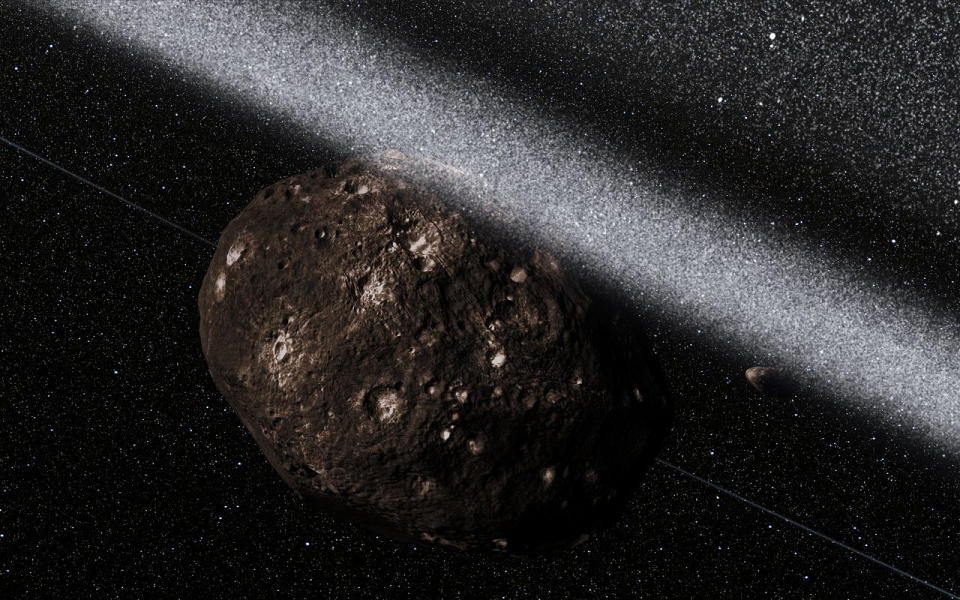A little moonlet, too small to be seen from Earth, could be playing cosmic sheepdog by shaping the thin rings around the distant minor planet Chariklo, according to new computer simulations.
Chariklo is a Centaur — a breed of small body that orbits the sun on a path sandwiched somewhere between Jupiter and Neptune. Centaurs are thought to come in from the Oort Cloud, which is a vast halo of trillions of frozen cometary bodies that extends possibly a light-year from the sun. Over the course of millions of years, they drift inward, either to be ejected from the solar system by the gravity of the giant planets, or to transition into Jupiter-family comets — comets with orbital periods of less than 20 years that are governed by the gravity of mighty Jupiter.
At about 155 miles (250 kilometers) in diameter, Chariklo is the largest known Centaur. In 2013, Chariklo was seen to pass in front of a distant star from our point of view, causing the star’s light to wink out briefly. Observations showed that not only did the solid body of Chariklo block the light, but so too did a pair of thin rings around the Centaur. Stellar occultations have shown that another Centaur, Chiron, also has rings, although they do not seem entirely stable.
Related: Centaur Chariklo has rings: Images of a space rock oddity (gallery)
“Rings around minor planets have only been recently discovered, and only a small number of such systems are currently known,” Amanda Sickafoose, a senior scientist at the Planetary Science Institute in Arizona, said in a press statement.
Chariklo’s two rings are located about 243 miles and 252 miles (391 and 405 km), respectively, from the center of Chariklo, although measurements can vary slightly. The rings themselves are narrow, just 4.3 miles and 1.9 miles (7 and 3 km) wide.
These rings are not like the rings of the giant planets, which are retained by the gravity of such huge worlds. Computer models show that Chariklo’s rings should be short-lived, and that they should widen and then disperse. So what’s keeping them in place?
Sickafoose and Mark Lewis, a computer scientist at Trinity University in San Antonio, performed N-body computer simulations of the rings made up from millions of particles, and showed that the influence of a small moonlet could keep the rings narrow and prevent them from dispersing.
“We’ve shown that one of the possibilities for thin rings to exist around small bodies is that they are being sculpted by a small satellite,” Sickafoose said.
Shepherd moons are nothing new; all the gas giant planets have them, most notably Saturn, where the tiny moons Daphnis, Epimetheus, Janus, Pan and Prometheus carve gaps in Saturn’s rings and then herd the ring material to keep it tidy.
Chariklo’s shepherd moon, if it existsl, would be about 1.9 miles (3 km) across and contain a mass on the order of 10 trillion kilograms (about 22 trillion pounds here on Earth). Although it is too small to be directly observed from Earth at Chariklo’s distance — the Centaur’s elongated orbit gets as close to the sun as 1.2 billion miles (1.9 billion km) and as far away as 1.7 billion miles (2.8 billion km) — its presence could be detected during stellar occultations.
There is one other possible explanation for the rings’ staying power. If we suppose that a gravitational anomaly exists within Chariklo — a denser part of rock, for example — then gravitational resonances between the rings and the anomaly could help tie the rings down. The rings do orbit in a nearly 1:3 resonance with the Centaur, meaning that Chariklo rotates three times (once every seven hours) for every one rotation of the rings. However, the rings are also placed suspiciously close to the Roche limit. This is the distance from a central body within which gravity prevents particles from accreting into a moon. Being right on the edge of this limit means that the ring particles should be able to start sticking together to build a new moon. A shepherd moon’s gravity would be able to intervene to prevent this.
“A satellite in this situation can perturb the ring material and prevent it from accreting,” said Sickafoose.
Related: Mighty morphin’ Centaur rings — a distant icy object’s rings are transforming

RELATED STORIES:
— Centaurs Rising: NASA eyes missions to weird asteroid-comet hybrids
— Asteroid found with rings! First-of-its-kind discovery stuns astronomers (video, images)
— What if the same spacecraft studied mysterious icy bodies and the cosmos as well?
“We think that the ring particles are primarily made of water ice, like those at the gas giants,” said Sickafoose. Indeed, the James Webb Space Telescope detected water-ice there in 2023. However, things that we don’t know include how “hard” or “soft” the particles are when they collide, or the distribution of particle sizes in the rings.
It is also unknown how the rings formed in the first place. Have they been outgassed by cryovolcanism on the surface of Chariklo, or are they the remains of a small body that got too close to Chariklo, inside the Roche limit, and was torn apart?
The findings were published on Feb. 6 in The Planetary Science Journal.
Signup bonus from





